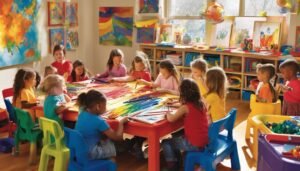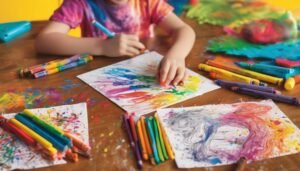Coloring enhances fine motor skills, boosts hand-eye coordination, and fosters emotional expression in young children. As your child picks up a crayon, they’re not just creating art; they’re developing vital skills that will support their growth. Each stroke and color choice can reveal insights into their emotions and thoughts. Understanding this connection can transform how you approach their creative activities, sparking curiosity about the deeper benefits of such a simple yet impactful pastime.
Key Takeaways
- Coloring enhances fine motor skills by strengthening hand muscles and refining grip through various coloring techniques.
- It boosts hand-eye coordination, enabling children to color within lines and improving their spatial awareness.
- Engaging in coloring fosters emotional expression, allowing children to communicate feelings through color choices.
- Coloring supports cognitive development by promoting color recognition, pattern identification, and essential skills for writing.
- It encourages creativity and imagination, providing a platform for children to visualize thoughts and explore their artistic potential.
Enhancing Fine Motor Skills
As you watch your child color, you mightn’t realize how much they’re actually developing their fine motor skills. Every time they grasp a crayon, they’re practicing essential movements that strengthen their hand muscles.
By experimenting with different coloring techniques—like shading, blending, or outlining—they refine their grip and control. This hands-on activity also promotes color recognition, as they learn to identify and name hues while making choices about what to use.
Encouraging them to fill in small spaces or create intricate designs not only boosts their creativity but also enhances dexterity.
Boosting Hand-Eye Coordination
Coloring can significantly boost your child’s hand-eye coordination, an essential skill for many daily activities. As they grasp crayons and stay within the lines, they’re also enhancing their spatial awareness and color recognition. This process helps them connect visual input with motor output, laying the foundation for future tasks like writing or playing sports.
Here’s a quick look at how coloring contributes to these skills:
| Activity | Benefit |
|---|---|
| Coloring within lines | Improves precision |
| Mixing colors | Enhances color recognition |
| Drawing shapes | Develops spatial awareness |
| Using different tools | Encourages adaptability |
| Following patterns | Boosts logical thinking |
Fostering Emotional Expression
While children often struggle to articulate their feelings, coloring provides a unique outlet for emotional expression. When you hand your child a box of crayons, you’re not just offering a creative activity; you’re giving them a chance to explore their emotions.
Different colors can symbolize various feelings—blue for sadness, red for anger, and yellow for happiness. By choosing colors that resonate with them, your child can communicate their emotional landscape without words. This practice fosters emotional wellness, helping them understand and manage their feelings effectively.
As they color, encourage discussions about their choices, reinforcing the connection between colors and emotions. In this way, coloring becomes a powerful tool for nurturing your child’s emotional intelligence and resilience.
Supporting Cognitive Development
Building on the emotional insights gained through coloring, this activity also plays a significant role in supporting cognitive development. When you encourage your child to color, they’re not just having fun; they’re sharpening essential skills like color recognition and pattern identification.
Here are a few key benefits of coloring for cognitive growth:
- Color Recognition: Identifying and naming colors enhances their ability to recognize differences and categorize information.
- Pattern Identification: Coloring within lines and choosing color schemes helps children understand patterns, which is crucial for math and reading skills.
- Fine Motor Skills: The act of coloring improves hand-eye coordination and dexterity, laying the groundwork for writing.
Encouraging Creativity and Imagination
When you provide your child with the opportunity to color, you’re not just offering a fun pastime; you’re opening the door to a world where their creativity and imagination can flourish.
Allowing them to explore different color choices lets them express their feelings and ideas. Each stroke of the crayon or marker encourages them to visualize their thoughts in vibrant ways.
Frequently Asked Questions
What Age Is Best for Introducing Coloring Activities?
You can introduce coloring activities around 18 months, aligning with developmental milestones. By age two, children are eager to express creativity. Following age recommendations ensures they engage with the activity, enhancing their fine motor skills and imagination.
How Can Parents Encourage Their Children to Color More?
You can encourage your child to color more by establishing consistent coloring routines and exploring various art styles together. This not only fosters creativity but also nurtures their art appreciation, making it a joyful experience.
Are There Specific Coloring Tools That Are Better for Young Children?
Crayons are often best for young kids due to their safety and ease of use. Opt for non-toxic varieties, like soy or beeswax. If using markers, ensure they’re washable and labeled safe for children’s use.
How Does Coloring Impact Social Skills in Young Children?
Coloring fosters social interaction and collaboration among young children. As they share tools and ideas, they develop communication skills and learn to cooperate, building friendships and enhancing their ability to work together in creative projects.
Can Coloring Help With Color Recognition and Learning?
Yes, coloring can significantly enhance color recognition and learning colors. As you guide children through vibrant hues, they’ll not only enjoy the creative process but also solidify their understanding of different colors in a fun way.
Conclusion
So, while you might think coloring is just child’s play, it’s actually a powerhouse of development. Who knew that those squiggles and splashes of color could enhance fine motor skills and ignite creativity? This simple activity not only boosts hand-eye coordination but also nurtures emotional expression and cognitive growth. Next time you see a child with crayons, remember: they’re not just doodling; they’re crafting the building blocks of their future. Isn’t it ironic how something so fun can be so impactful?




